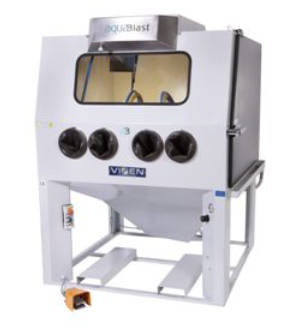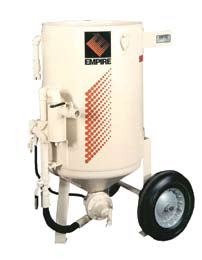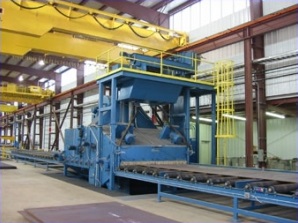The Black Ink Team's Guide To Abrasive Blasting
by Black Ink Team
Abrasive blasting is when a machine is used to hurtle large amounts of small objects at a surface in order to turn it from a rough surface into a smooth surface, or vice versa. It is a method that is commonly used to remove rust. Different blasting material (or ’media’) is used for different applications. The heavier or harder the media, the deeper it scores the surface.

Aquablast’s 1515 Wet Blasting Machine
Metal shot (small metal balls) is the toughest media that gets used for abrasive blasting – when it is used, it is called ‘shot blasting.’ Shot blasting is frequently used during the cleaning phase of the metalcasting process. When a casting comes out of its mold, it usually has a layer of burnt sand on it which needs to be scraped or blasted off. Sometimes it also has scale – metal that has oxidized with the air and as a result has less structural integrity than is desired. In addition to cleaning, shot blasting can also be used in metalcasting for ‘peening’ – hammering the surface of a metal object to make it more resilient.

Empire’s SuperBlast Portable Blaster
For less severe applications, such as working on cement, wood, or ceramic, lighter media gets used. Sand is a common media for moderate abrasive blasting – when it is used, it is called ‘sandblasting.’ Plant material such as walnut shells and corn cobs gets used for light abrasive blasting. Plastic or glass can be used as a softer alternative to shot. When plastic or glass beads are used, it is called ‘bead blasting.’ The substance that gets used for the least intense abrasive blasting is baking soda. Most abrasive blasting media can be reused, but only after it has been sifted for large pieces of the surfaces that have been worked on, which can jam the equipment.

Blastec’s Wheel Plate Machine
There are 3 types of abrasive blasting equipment: ‘pneumatic,’ ‘hydraulic,’ and ‘wheel.’ Pneumatic machinery propels the media using pressurized air. One of the dangers workers face when using pneumatic machinery is dust – lots of fine particles get blown into the air, so they should be wearing a mask. Hydraulic machinery propels the media using pressurized water, and has the advantage that it reduces the amount of dust that gets thrown into the air. ‘Wheel’ abrasive blasting equipment relies on a quickly spinning wheel to shoot media out through the nozzle. Since they get subjected to lots of abrasion, the nozzles on abrasive blasting equipment need to be made out of a very strong substance and often need to be replaced.
